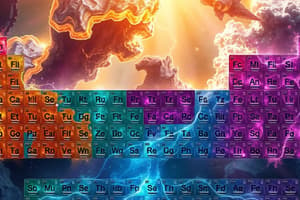Podcast
Questions and Answers
What charge do alkali metals have?
What charge do alkali metals have?
- 0
- +2
- +3
- +1 (correct)
How many valence electrons do alkaline earth metals have?
How many valence electrons do alkaline earth metals have?
2
What is the charge of halogens?
What is the charge of halogens?
-1
What is the charge of noble gases?
What is the charge of noble gases?
The charge of group 1/1A is ______
The charge of group 1/1A is ______
The charge of group 2/2A is ______
The charge of group 2/2A is ______
The charge of group 3A/13 is ______
The charge of group 3A/13 is ______
The charge of group 5A/15 is ______
The charge of group 5A/15 is ______
The charge of group 6A/16 is ______
The charge of group 6A/16 is ______
The charge of group 7A/17 is ______
The charge of group 7A/17 is ______
The charge of group 8A/18 is ______
The charge of group 8A/18 is ______
What are the rows on a periodic table called?
What are the rows on a periodic table called?
What are the columns on a periodic table called?
What are the columns on a periodic table called?
How is the periodic table arranged according to Mendeleev?
How is the periodic table arranged according to Mendeleev?
How is the modern periodic table arranged?
How is the modern periodic table arranged?
What do elements in the same row/period have in common?
What do elements in the same row/period have in common?
What do elements in the same group have in common?
What do elements in the same group have in common?
Most of the periodic table is made of nonmetals.
Most of the periodic table is made of nonmetals.
How many valence electrons are in group 15?
How many valence electrons are in group 15?
How many valence electrons are in group 16?
How many valence electrons are in group 16?
Flashcards are hidden until you start studying
Study Notes
Alkali Metals
- Have a +1 charge and possess 1 valence electron.
Alkaline Earth Metals
- Carry a +2 charge with 2 valence electrons.
Transition Metals
- Positioned in the center of the periodic table, known for varied oxidation states and ability to form colored compounds.
Halogens
- Contain 7 valence electrons and have a -1 charge.
Noble Gases
- Feature 8 valence electrons (except helium which has 2) and have a 0 charge, known for their inertness.
Rare Earth Metals
- A group of 15 elements from lanthanum to lutetium, often exhibit similar properties and are found in the f-block.
Nonmetals
- Elements typically poor conductors of heat and electricity, can gain or share electrons in chemical reactions.
Metalloids
- Have properties that are intermediate between metals and nonmetals, often exhibit semiconducting behavior.
Charge of Group 1 (1A)
- Elements in this group have a charge of +1.
Charge of Group 2 (2A)
- Elements in this group carry a charge of +2.
Charge of Group 3A (13)
- Elements in this group possess a charge of +3.
Charge of Group 5A (15)
- Elements in this group have a charge of -3.
Charge of Group 6A (16)
- Elements in this group exhibit a charge of -2.
Charge of Group 7A (17)
- Elements in this group have a charge of -1.
Charge of Group 8A (18)
- Elements in this group have a charge of 0.
Periods
- Horizontal rows in the periodic table indicating elements with the same number of electron shells.
Groups
- Vertical columns on the periodic table that group elements with similar properties and the same number of valence electrons.
Atomic Mass
- Historically used by Mendeleev to arrange the periodic table based on the mass of elements.
Atomic Number
- The modern periodic table is organized by the atomic number, representing the number of protons in an atom.
Energy Levels
- Elements in the same period have the same number of energy levels, also known as electron shells or orbitals.
Valence Electrons
- Elements in the same group share the same number of valence electrons, impacting their chemical behavior.
Metals
- Comprise the majority of the periodic table, characterized by good conductivity and malleability.
Valence Electrons in Group 15
- Elements in group 15 have 5 valence electrons.
Valence Electrons in Group 16
- Elements in group 16 possess 6 valence electrons.
Studying That Suits You
Use AI to generate personalized quizzes and flashcards to suit your learning preferences.




